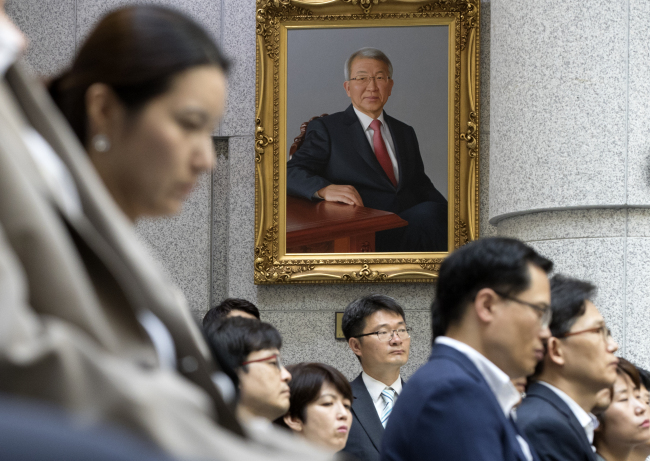One of the major power abuse allegations that Yang Sung-tae, the former Supreme Court chief justice, faces is his use of “politically sensitive” trials as bargaining chips to gain presidential approval for establishing an appellate court in the country’s judiciary.
Questions have been raised as to why Yang, along with other judges at the Supreme Court, was so desperate to create the new court that he would lobby lawmakers, Cheong Wa Dae staff under then-President Park-Geun-hye and even journalists and popular TV personalities to comment favorably on his plan.
It has also been recently revealed that under Yang’s leadership, the Office of Court Administration spent some 320 million won ($285,000) of taxpayers’ money to create online cartoons, YouTube videos and even subway ads on Seoul Metro promoting the need for an appellate court, from 2014-2015.
 |
A portrait (framed) of Yang Sung-tae, the former Supreme Court chief justice, is hung on the wall of one of the rooms at the Supreme Court of Korea in southern Seoul. Yang is currently suspected of using the National Court Administration to influence judicial outcomes in line with the now-ousted Presdient Park Geun-hye and her administration`s political agenda(Yonhap). |
An appellate court is a court of law that is empowered to hear an appeal against a decision by a trial court or other lower tribunal. What Yang wanted was a de facto second Supreme Court, a court that would have functioned as a bridging institution between the top court and other appellate courts.
Yang’s plan, however, never materialized, as the idea failed to obtain endorsement from Cheong Wa Dae.
The proposal to revise relevant laws to establish the court was initially submitted to the National Assembly in 2015 by Rep. Hong Il-pyo of the then-ruling Saenuri Party, a previous incarnation of today’s Liberty Korea Party.
The proposal claimed an appellate court was necessary as judges at the Supreme Court are very often overworked, posing a threat to the country’s justice system.
If an appellate court were established, Supreme Court judges would be able to focus on appeals that required reinterpretation of the country’s existing laws, as well as high-profile cases of public interest, while non-Supreme Court judges could handle other appeals with more time and consideration, it said.
Despite Yang’s attempts to strike a deal with Cheong Wa Dae, the presidential office reportedly did not endorse the idea of establishing the particular court, fearing it would significantly reduce the president’s influence within the judiciary.
One of the trials Yang allegedly used as bargaining chips for political favors from the presidential office was a compensation suit filed by elderly Koreans who were subject to forced labor during Japan’s colonial rule against two Japanese companies.
The Supreme Court had already ruled in favor of the Korean victims in 2012, but the case had been pending at the court until it resumed the hearing last year. The reasons for the delay had never been clear. While waiting for the verdict, seven of the nine elderly victims died.
Some experts say Yang desperately wanted the appellate court as he sought to dominate what would have been the second-most powerful court in the country by seizing the authority to select and appoint judges for the institution.
Other experts, including Lee Ho-joong, a criminal law professor at Sogang University, claim Yang’s obsession with establishing the court was an attempt to maintain the privileges enjoyed by Supreme Court judges while lessening their workload.
Lee claimed that the Supreme Court could have addressed its heavy workload by increasing the number of Supreme Court judges, rather than establishing a lower court. The Supreme Court consists of 14 judges, including the chief justice.
“The plan is to sustain the privileges of Supreme Court judges by not sharing their power with others,” Lee wrote in a 2015 column. “(If it had been carried out), the judiciary would have continued to be dominated by a very small number of elites.”
By Claire Lee (
dyc@heraldcorp.com)








![[Today’s K-pop] Blackpink’s Jennie, Lisa invited to Coachella as solo acts](http://res.heraldm.com/phpwas/restmb_idxmake.php?idx=644&simg=/content/image/2024/11/21/20241121050099_0.jpg)